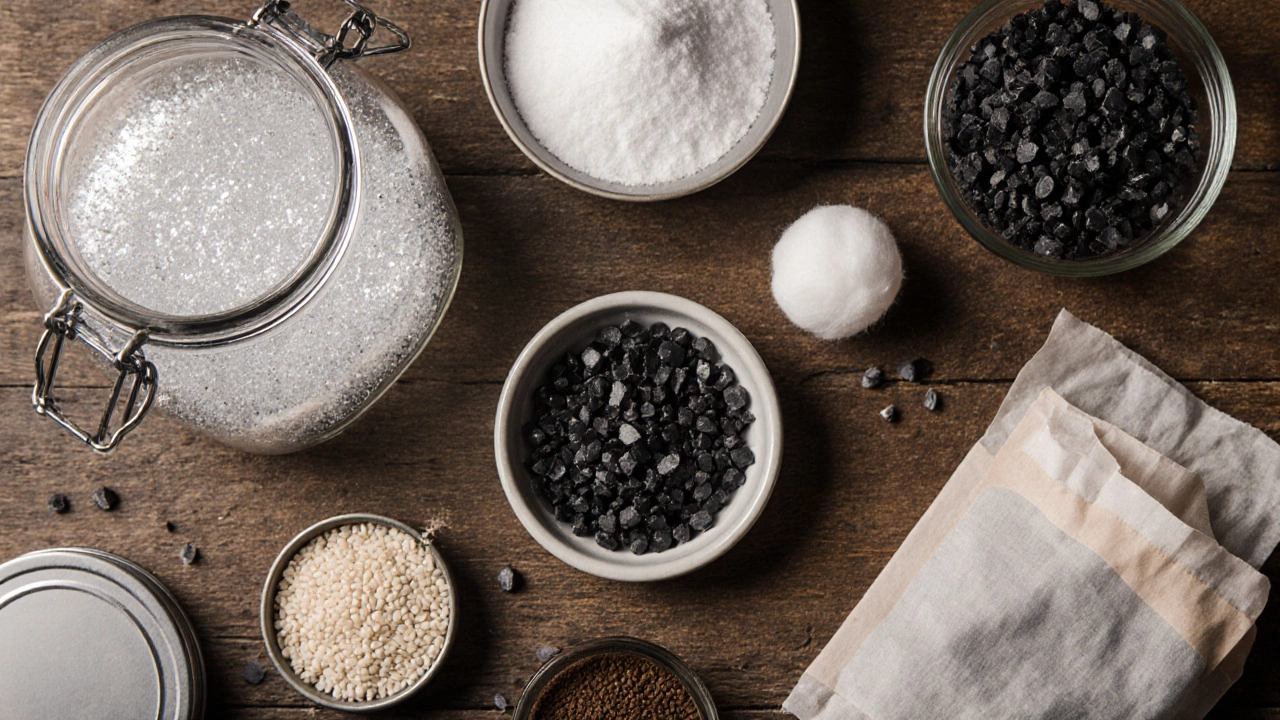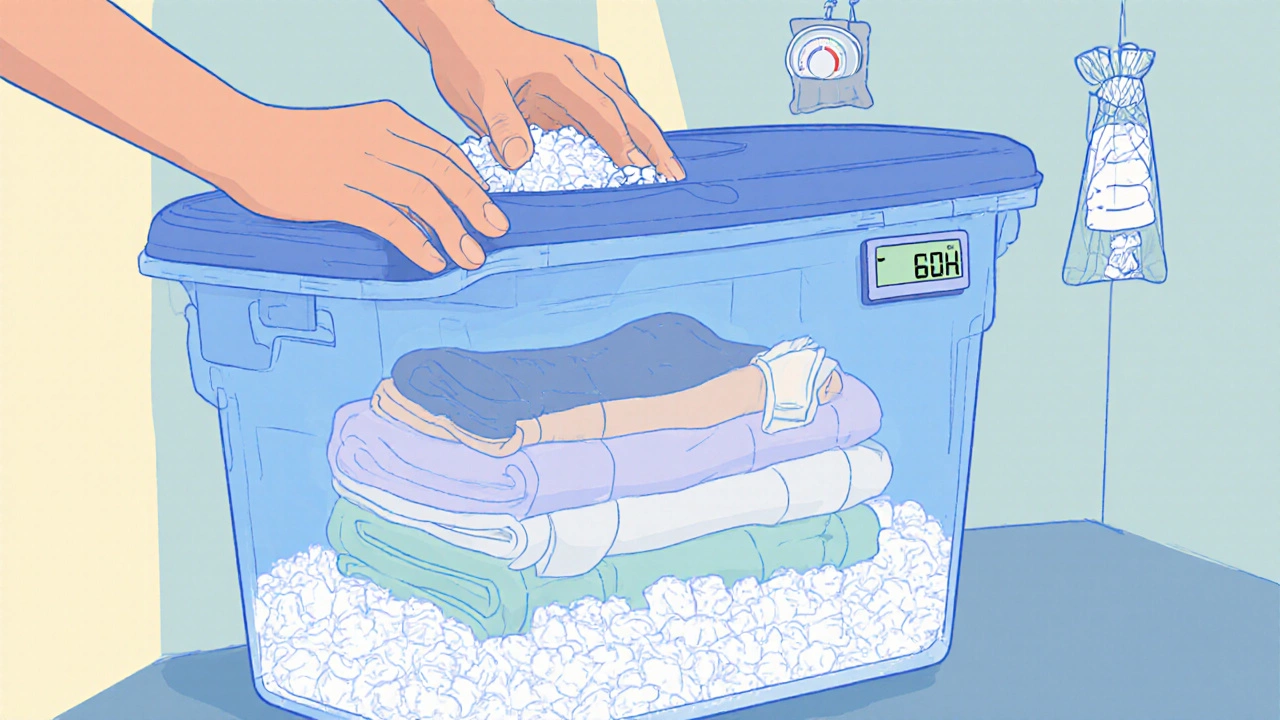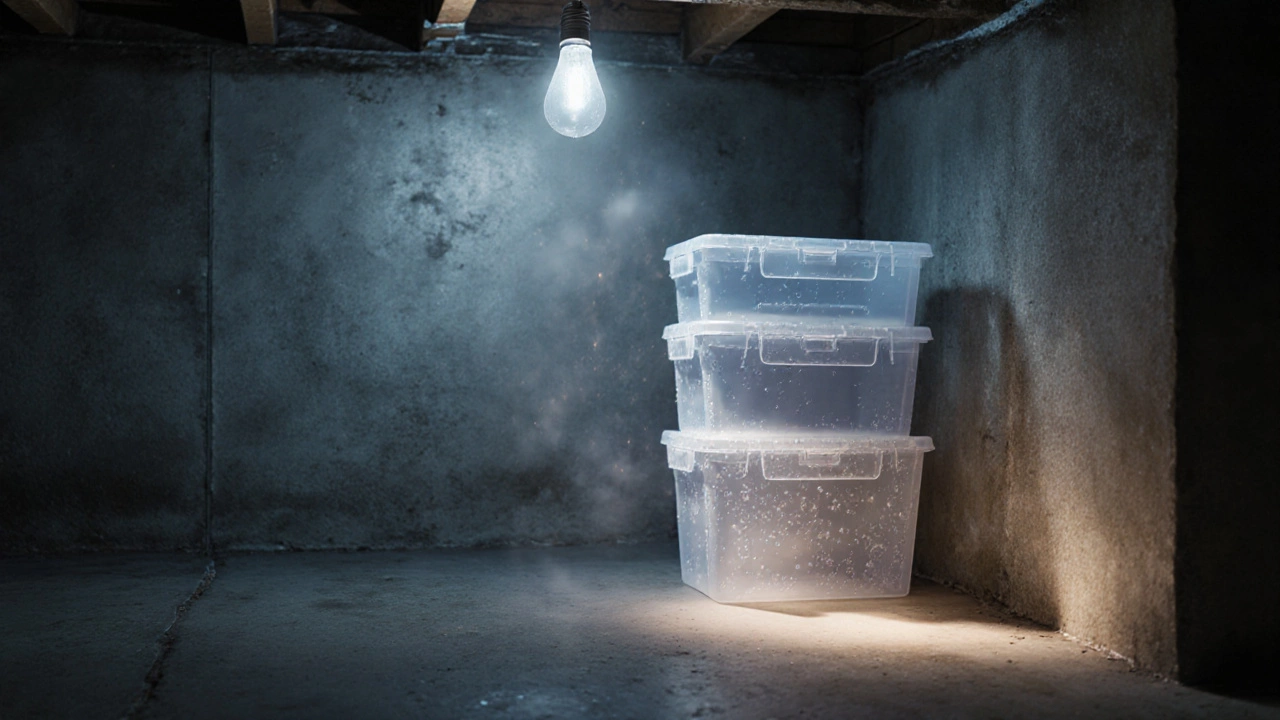Storage Bin Desiccant Selector
Recommended Desiccant:
This tool evaluates your storage needs based on item type, bin size, budget, and environment to recommend the most suitable desiccant for preventing mold growth.
- Clothing & Linens: Recommend silica gel or baking soda for odor control and moisture absorption.
- Paper Documents: Suggest activated charcoal for odor and moisture control.
- Electronics: Recommend rice or silica gel for gentle moisture absorption.
- General Storage: Balanced recommendation based on your budget and environment.
When you stash seasonal clothes, holiday décor, or surplus pantry items, the last thing you want is a musty surprise. Mold prevention is a set of practices and materials that keep moisture‑driven fungi from growing on stored goods.
Most mold outbreaks start with tiny droplets of water that settle inside a bin and never dry out. The solution isn’t a fancy airtight container-it’s what you put inside the container to keep the air dry and the air clean. Below we break down the best options, how they work, and which one fits your budget and space.
Key Takeaways
- Silica gel packs absorb up to 40% of their weight in water and are reusable after drying.
- Baking soda is cheap, safe, and also neutralizes odors while absorbing moisture.
- Activated charcoal removes both moisture and lingering smells without leaving a residue.
- Calcium chloride works fastest but can become soggy; pair it with a secondary barrier.
- Combine physical desiccants with good bin placement and regular monitoring for the best mold‑free results.
Why Moisture Is the Real Enemy
Even a seemingly dry basement can hold 60-80% relative humidity. When that humidity meets a cold surface-like a plastic storage bin-it condenses into liquid droplets. Those droplets are a buffet for mold spores, which are practically everywhere in the air.
Two factors decide whether mold will grow:
- Water activity (aw): When aw stays above 0.80, most molds can thrive.
- Temperature: Warm spots (above 68°F/20°C) accelerate growth.
Keeping the aw below 0.60 inside your bin is the sweet spot. That’s where desiccants and absorbent powders come in.
Top Desiccants and Absorbents
Below are the most common, budget‑friendly, and effective substances you can toss into a storage bin. The first time each appears we add microdata markup.
Silica gel is a granular, synthetic silica composed of tiny pores that attract water molecules. It can absorb roughly 40% of its own weight in moisture and is reusable after heating at 250°F (120°C) for a few hours.
Baking soda (sodium bicarbonate) is a household staple that absorbs moisture and neutralizes odors. One cup can pull in about 0.5lb of water over several weeks.
Activated charcoal is carbon treated with oxygen to create a massive surface area. It traps moisture and volatile organic compounds, making it ideal for musty closets.
Calcium chloride is a hygroscopic salt that crystallizes water quickly. A 500g bag can pull in up to 300g of moisture, but it leaves a wet residue that must be contained.
Rice grains are a low‑cost, low‑tech alternative. They absorb water slowly and are best for small boxes like electronics cases.
Dryer sheets release a mild fragrance and have a tiny amount of moisture‑absorbing chemicals. They’re not as powerful as silica gel but add a fresh scent.
Essential oil drops (e.g., tea tree or lavender) have natural antifungal properties. Adding a few drops to a cotton ball inside the bin can inhibit spore growth.
Vinegar packets made from cotton soaked in white vinegar create a mildly acidic environment that discourages mold. Replace every month.

Comparison Table: Desiccants at a Glance
| Desiccant | Absorption Capacity (g/100g) | Typical Cost (USD) | Reuse Ability | Safety / Residue |
|---|---|---|---|---|
| Silica gel | 40 | 0.20-0.30 per pack | Yes (heat‑dry) | Non‑toxic, no residue |
| Baking soda | 10‑15 | 0.05 per cup | No (replace) | Food‑grade, safe |
| Activated charcoal | 20‑25 | 0.15 per ounce | Limited (shake out moisture) | Non‑toxic, may stain light fabrics |
| Calcium chloride | 60‑70 | 0.10 per 500g | No (becomes brine) | Corrosive; keep away from metal |
| Rice grains | 5‑8 | 0.02 per cup | No (replace) | Food‑grade, may attract insects if not sealed |
How to Pack Your Bin for Mold‑Free Storage
- Choose a breathable but sturdy bin (plastic with vent holes or canvas). Avoid sealed glass jars unless you also control the internal humidity.
- Lay a thin layer of the chosen desiccant at the bottom. For a 20‑liter bin, 100g of silica gel or 200g of baking soda works well.
- Wrap delicate items (clothing, linens) in cotton sleeves or acid‑free tissue. This adds an extra barrier and lets moisture circulate evenly.
- Scatter a second layer of desiccant on top of the items before sealing the lid.
- If you use calcium chloride, place it in a sealed perforated pouch (e.g., a mesh bag) to contain the liquid that forms.
- Label the bin with the date you packed it and the type of desiccant used. This helps you rotate stock and replace absorbents on schedule.
- Store the bin in a climate‑controlled area. Ideal spots are closets with 60-70% relative humidity and temperatures between 55°F-70°F (13°C-21°C).
Monitoring and Maintenance
Even the best desiccants need checking. Here’s a quick routine you can stick to:
- Monthly visual scan: Look for any damp patches, discoloration, or a musty smell.
- Desiccant check: Silica gel packs often turn from blue to pink when saturated (if they contain a moisture indicator). Replace or reactivate them.
- Humidity gauge: Place a small digital hygrometer inside the bin (or the shelf where the bin sits). Aim for < 60% RH.
- Rotate goods: Use the “first‑in, first‑out” rule for seasonal items. Older items get used before newer ones, reducing storage time.
When a desiccant has reached its limit, simply heat‑dry silica gel, spread fresh baking soda, or swap out a calcium chloride pouch. The effort is minimal compared with the cost of ruined clothing or damaged paperwork.

Special Scenarios & Pro Tips
Electronics: Moisture can corrode connectors. Use rice grains or silica gel wrapped in a breathable fabric, and consider a silica‑gel‑filled zip‑lock bag that sits on top of the device rather than inside it.
Paper archives: Add a thin layer of activated charcoal between stacks. Charcoal’s odor‑absorbing properties keep the paper smelling fresh, and its moisture‑binding surface slows mold.
Outdoor storage sheds: Summer heat spikes humidity inside metal sheds. Pair a dehumidifier (if you have power) with calcium chloride buckets placed on shelves. Cover buckets with a tray to catch runoff.
DIY desiccant packs: Fill a breathable muslin bag with equal parts silica gel and baking soda. The combo gives fast absorption (silica) plus odor control (baking soda). Seal the bag with a twist tie.
Eco‑friendly option: Reuse coffee grounds after brewing. They absorb a modest amount of moisture and add a pleasant scent. Swap them out every two weeks.
What Not to Do
- Don’t store items directly on the floor of a damp basement; moisture rises from the ground.
- Avoid airtight containers unless you also control the internal humidity; sealed air traps moisture.
- Never use metal desiccant containers with calcium chloride near metal tools; the brine can cause rust.
- Skip cheap “anti‑mold” sprays that only mask odors; they don’t address the underlying moisture.
Frequently Asked Questions
Can I reuse silica gel forever?
Silica gel can be re‑activated many times by heating it in an oven at 250°F (120°C) for 2‑3 hours. Over years the granules may break down, but for most home users they last indefinitely.
Is baking soda safe for all items?
Yes, it’s food‑grade and non‑corrosive, making it safe for fabrics, paper, and most plastics. Avoid it with delicate electronics where powder could seep into crevices.
How often should I replace the desiccant?
Check the indicator color or weigh the pack. As a rule of thumb, silica gel packs are refreshed every 3‑6 months, baking soda every 6 months, and calcium chloride when the pouch feels wet.
Do I need a dehumidifier if I use desiccants?
Desiccants handle localized moisture well, but a whole‑room dehumidifier helps keep ambient humidity low, extending the life of all your storage bins.
Can I make my own desiccant at home?
Absolutely. Mix equal parts silica gel (purchased in bulk) with baking soda, seal in breathable fabric, and you have a reusable, high‑capacity pack. Coffee grounds and uncooked rice are also easy DIY options.
By choosing the right filler, keeping the bin in a sensible spot, and checking on things every few weeks, you’ll stop mold before it even gets a chance to set in. Your seasonal sweaters, holiday decorations, and important documents will stay fresh for years to come.
